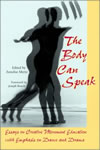 |
 |
 |
 |
![]()
Volume 6,
Issue 3,
Spring 2003
|
The Body Can Speak Mertz, Annelise (Editor), Roach, Joseph (Foreword)Southern Illinois University Press, 2002 224 pages, 48 illustrated Hardcover: US $40.00 |

|
Reviewed by: Jessica
Tomell-Presto, Southern
Illinois University at Carbondale
Printer-friendly PDF
version
The Body Can Speak is a collected volume of nineteen essays edited by Annelise Mertz.1 The contributors to this volume have a broad range of experiences in movement technique, teaching methods, and other related areas of interest. The book is marketed as having an emphasis in dance; however, like other dance scholarship, the "dance" discussed may be anything from modern dance to martial arts to unstructured movement. The goal of these authors seems to be to "cultivate a consciousness of movement" (Sheehy 125). This volume includes some discussion of the use of visual and dramatic arts as well.
In this collection, dance is being recognized as more than an art form or aesthetic. The authors advocate a number of related reasons for studying movement. For some, dance provides an opportunity to find the connection between mind and body. Dance is considered a language, although it may not convey a narrative. Others believe that movement is a way of exhibiting what you have learned; students need a way of putting what they have learned into action. Dance can be a means of expression of inner emotions or means of finding self-awareness. It can be a means of therapy,2 both physical and psychological. Movement is also recognized as having an impact on the formation of intelligence in children.
The book is divided into two parts. Part One is a number of persuasive essays about the necessity of incorporating movement into general education at all levels. This volume mirrors other scholarship in the arts in that it feels the need to justify its study. For example, in Choreographing Difference, Albright discusses dance "as a way of knowing and experiencing the world; one that [is] no less sophisticated than other forms of knowledge" (xii). Although the arguments in The Body Can Speak are well stated, for those who are interested in the arts, these initial chapters contain familiar information.
The preceding arguments are restated throughout the volume. However, Part Two, as evidenced in the title, "How We Do It", is meant to switch from the philosophical to the practical. Examples are given in which movement, visual art materials, poetry, and drama are used to teach mathematics, cell structure, self-expression, and job interview skills.
In this section, G. Hoffman Soto discusses his first experience in a dance classroom. His personal narrative encourages an empathetic response for any new, awkward student in a dance class. He describes the humiliation he experienced and related it to the experience any student would feel learning a new physical activity. Although his narrative does not address these issues explicitly, his experience hints at cultural and gendered expectations for the athlete and dancer's body. Shirley Ririe leads an interesting discussion of the benefits of improvisation, which may be the key to true collaboration in choreography and a way of finding individual meaning in movement. She suggests that a dancer needs to feel that the movement in a choreographed piece belongs to him/her. Joan Woodbury and Emma Sheehy provide two poignant stories. Woodbury describes her experience with a dance troupe at a Bosnian refugee camp and Sheehy encourages teachers of all types to value children's nonconformist movement. These are just a few samples of the essays included in this section.
Although Part Two is entitled, "How We Do It", the number of exercises or examples that readers would be able to apply in their own classroom is limited. The essays provide possibilities, but few details explaining methods. Dance therapy and improvisation technique cannot be taught in a few chapters. The reader would benefit from more examples like the exercise for teaching geometric shapes with string and students' bodies.
The goal of this volume is to create a consciousness of movement or to explain how movement can be used as a pedagogical tool. The goal is not to become conscious of how movement reflects and creates the cultural and gendered identity of the dancer.3 It does, however, inspire the instructor to use movement in any type of classroom to stimulate the responsiveness of students, to make connections between disciplines and ideas, and to encourage understanding and self-awareness.
Works Cited
Albright, Ann Cooper. Choreographing Difference: The Body and
Identity in Contemporary Dance. Hanover: Wesleyan University Press, 1997.
Sheehy, Emma D. "Dance." The Body Can Speak. Ed. Annelise Mertz. Carbondale: Southern Illinois Press, 2002. 112-125.
Endnotes
1. Annelise Mertz is Professor Emerita of Dance at Washington
University in St. Louis. For more information about her please visit http://wupa.wustl.edu/record/archive/2001/03-02-01/articles/mertz.html.
2. For an explanation of dance therapy: http://www.medicomm.net/Consumer%20Site/am/dance.htm OR http://www.studyoverseas.com/performingarts/eds/dance.htm.
3. For an example of this argument, see Fraleigh, Sondra Horton and Penelope Hanstein, Eds. Researching Dance: Evolving Modes of Inquiry. Pittsburgh: University of Pittsburgh Press, 1999.
Back to Top
Home | Current
Issue | Archives | Editorial
Information | Search | Interact